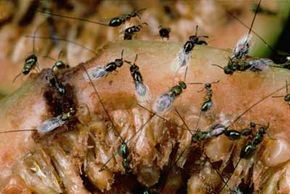Quck answer
Wasps are insects that belong to the order Hymenoptera, which also includes bees and ants. They have a slender body, two pairs of wings, and a stinger. Wasps are predators and feed on other insects, spiders, and even small animals. They are beneficial to humans because they help control the population of pests. Wasps have a complex social structure and live in colonies. The queen lays eggs, and the workers take care of the young and defend the nest. Wasps communicate with each other through chemical signals and body language. They play an important role in the ecosystem and are fascinating creatures to study.
Wild Animals
Classification of Wasps

Female fig wasps hatch from holes created by blind, wingless male fig wasps in Barro Colorado Island, Panama.
Mark Moffet/Minden Pictures/Getty Images
It’s impossible to describe the vast anatomical and social diversity of wasps in a single article due to the large number of wasp species in existence worldwide. Therefore, we’ve selected a few intriguing species for a closer look.
Fig Wasps
Why transport food to your offspring back at the nest when you can build the entire nest inside your food source? That’s exactly what fig wasps do. There are 900 species of fig wasp, each responsible for pollinating one or two species of fig plant. This results in a mutualistic relationship between the plant and insect.
A fertile female fig wasp locates the flowering parts of a fig plant, which are situated inside a fruit-like structure known as the syconium. She deposits her eggs there and introduces pollen to fertilize the plant. The larvae feed on plant tissue and ultimately develop into new fig wasps.
Does this imply that every time we eat a Fig Newton, we’re consuming wasp carbohydrates? No, because the fig plants that humans harvest produce two types of figs: edible figs and caprifigs. Females may only deposit eggs inside caprifigs, which quickly fill up with wasp eggs, while edible figs only contain seeds. To learn more about fig wasps, read “Are Figs Really Full of Baby Wasps?”
Yellow Jackets
Yellow jackets, the bane of many picnic-goers, appear to be primarily scavenging carnivores that enjoy sandwiches, barbecue, and fried chicken. However, like most wasps, they are primarily interested in sugary teas and sodas. The meat is for their larvae, not for them.
When they’re not bothering picnickers, yellow jackets are busy hunting a variety of insects that frequently prey on cultivated plants. Yellow jackets have a painful sting and will vigorously defend their underground nest if disturbed. Since the average yellow jacket colony contains between 2,800 and 5,000 wasps, it’s best to proceed with caution when you see their recognizable yellow and black coloration.
Cuckoo Wasps
These wasps discovered long ago that one of the greatest sources of food for their offspring was other wasp larvae. What better way to feed them than to leave them in another wasp’s nest? This brightly colored deadbeat mother deposits her eggs inside the nests of solitary bees and wasps. When the cuckoo larvae hatch, they consume the larvae and food left by the actual nest builders.
Velvet Ants
Despite their appearance, velvet ants are actually solitary wasps. While males have wings, females have abandoned them to better raid underground bee and wasp nests, where they lay their eggs to feed on the native larvae. Velvet ants have a fierce sting, and some are even capable of squeaking when they perceive a threat.
Despite their vital role in the ecosystem, you may be interested in getting rid of wasps. Whether you love or hate wasps, learn how to manage them near your home on the next page.
FAQ
1. What are wasps?
Wasps are a type of insect that belong to the Hymenoptera order, which also includes bees and ants. They come in a variety of shapes, sizes, and colors, and are found all over the world.
2. How do wasps differ from bees?
While wasps and bees are both members of the Hymenoptera order, there are some key differences between the two. Wasps are generally more aggressive than bees, and can sting repeatedly without dying. They also have slender waists, while bees have a more rounded body shape.
3. What do wasps eat?
Most wasps are carnivorous, and feed on other insects and spiders. Some species also feed on nectar and fruit juices. Adult wasps do not eat solid food, and instead regurgitate liquid food to feed their larvae.
4. What is the purpose of a wasp’s stinger?
The stinger on a wasp is primarily used for defense. When a wasp feels threatened, it can sting repeatedly to protect itself or its nest. However, some species of wasps also use their stingers to paralyze their prey before laying eggs on it.
5. How do wasps build their nests?
Most species of wasps build nests out of paper-like material, which they create by chewing up wood fibers and mixing them with saliva. The nests can be shaped like cones, balls, or even honeycombs, depending on the species.
6. Are wasps important to the ecosystem?
Yes, wasps play an important role in controlling populations of other insects and arthropods. They are also important pollinators, and help to fertilize plants and crops.
7. Can wasps be beneficial to humans?
While wasps are generally seen as pests, they can actually be beneficial to humans in some situations. For example, some species of wasps are used as natural pest control for agriculture, and can help to reduce the need for chemical pesticides.
8. What should I do if I encounter a wasp?
If you encounter a wasp, it’s important to remain calm and avoid swatting at it. Swatting can make the wasp feel threatened and increase the likelihood of being stung. If the wasp is near your home or workplace, it’s best to contact a pest control professional to safely remove it.





Leave a Reply